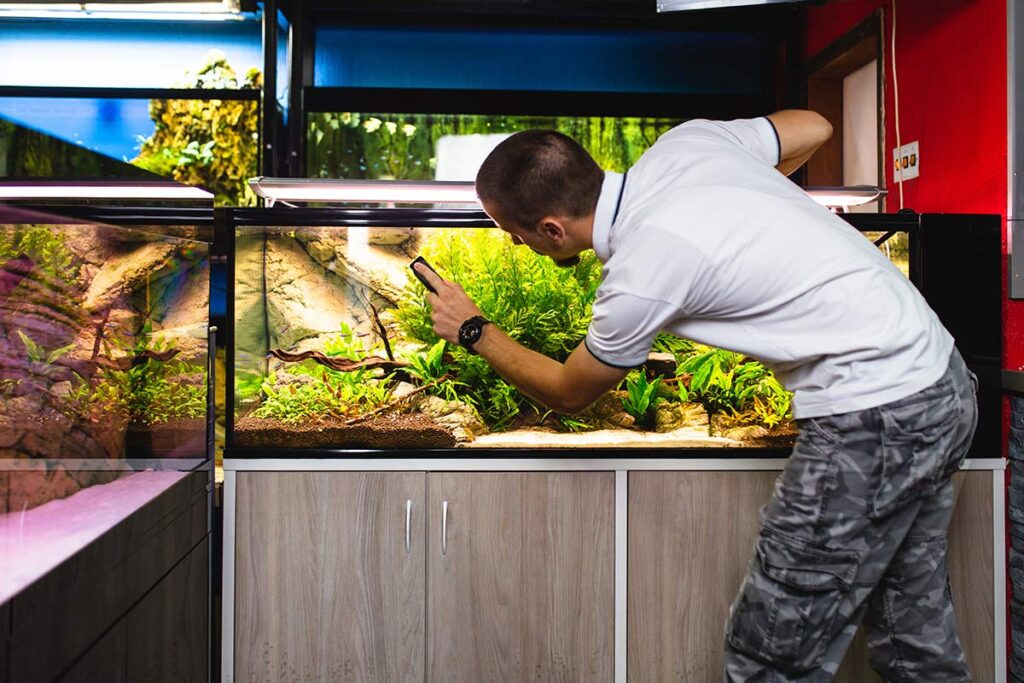
Key Takeaways
-
Identify the source of the leak by using a dry paper towel to trace along the seams of the aquarium.
-
Gather essential tools like aquarium-safe silicone, a razor blade, and acetone for cleaning.
-
Ensure the tank area is completely dry before attempting any repairs.
-
Use non-toxic, 100% silicone sealant specifically designed for aquarium use to patch leaks.
-
Allow ample curing time for the sealant before refilling the aquarium and monitoring for further leaks.
When you first spot that dreaded puddle of water beneath your aquarium, it’s easy to panic. But take a deep breath—most leaks can be managed successfully with a bit of know-how and the right approach. Let’s dive into how you can bring your tank back to its watertight glory.
Detecting a Leak in Your Aquarium
First things first, you need to locate the leak. It might be tempting to start patching up the first suspicious spot you see, but accuracy here is key. Grab a dry paper towel and gently press along the seams of the aquarium. Pay special attention to corners and edges where the sealant may have weakened. If the towel picks up moisture, you’ve likely found your culprit.
Tools and Materials You Will Need
Before you can embark on your DIY repair mission, you’ll need to assemble a few tools and materials:
-
A razor blade or scraper to remove old sealant.
-
Non-toxic, 100% silicone sealant that’s safe for aquarium use.
-
Acetone or alcohol wipes for cleaning surfaces.
-
Paper towels for drying and detecting leaks.
-
Protective gloves to keep your hands clean and safe.
Make sure you have all these items on hand before you start, because once the repair process begins, there’s no pausing for a hardware store run.
Addressing a Leak Without Draining
Here’s some good news: if the leak is small, you might not need to drain your entire aquarium to fix it. If the water level is above the leak, however, you’ll need to lower it to just beneath the affected area. This minimizes stress on your aquatic friends and keeps your repair zone dry.
Pinpoint and Prep the Leaky Area
Once you’ve found the leak, it’s time to prepare the surface. This is crucial—the success of your repair depends on how well you prep the area. Start by using your razor blade to scrape away any old, peeling sealant around the leak. Be careful not to scratch the glass. Then, clean the surface with acetone or an alcohol wipe to remove any residue. The cleaner the surface, the better the sealant will adhere.
Finding the Source of the Leak
If the leak isn’t immediately apparent, fill your patience and keep searching. Sometimes, leaks are sneaky and can travel from their origin to another spot in the tank. So if you’ve wiped down an area and it’s still dry, expand your search. Remember, water follows the path of least resistance, so track the trail back to its source.
Once you’ve confidently identified where the water is coming from, mark the spot with a piece of tape. This will be your target when you start the actual repair.
Cleaning the Affected Area for Repair
Thorough cleaning is non-negotiable. After scraping away old sealant, wipe the area down again. It should be free of any algae, grime, or dust. This isn’t just about making a good bond with the new sealant; it’s about ensuring there’s no contamination that could harm your tank’s inhabitants later on.
After cleaning, give the area plenty of time to dry. Any moisture left behind could prevent the sealant from curing properly, leading to more leaks down the road. Patience here will save you a lot of trouble later.
Method 1: Patching with Epoxy Putty
For leaks that require a sturdier fix or are located in a tricky spot, epoxy putty can be a lifesaver. This moldable adhesive is great for sealing leaks, especially in corners or around fittings where traditional sealants might not reach.
Mixing and Applying the Epoxy Putty
Start by kneading the epoxy putty according to the manufacturer’s instructions until it’s a uniform color. Once it’s ready, apply it over the leak, pressing firmly to ensure it gets into any cracks or gaps. Shape it smoothly so it doesn’t create any obstructions inside the tank.
Remember, epoxy putty starts to harden quickly, so you’ll need to work with a sense of urgency. But don’t let that rush you into a sloppy job—accuracy is still more important than speed.
Curing Time and Leak Reassessment
After applying the putty, it needs time to cure. This can take several hours or even a full day, depending on the product and conditions. Once it’s fully cured, fill the tank slightly above the repaired area and check for leaks again. If it holds up, you’re good to go. If not, it’s back to the drawing board—either with more putty or a different method.
Method 2: Sealing with Silicone
If epoxy putty isn’t suitable for your situation, silicone sealant is the next best option. It’s the go-to for most aquarium repairs because it’s flexible, waterproof, and, most importantly, safe for fish when cured.
Prepping the Surface for Silicone Application
As with the epoxy putty, you’ll need to ensure the surface is clean and dry. Use a razor blade to carefully remove any old silicone, taking care not to scratch the glass. Then, clean the area with acetone and allow it to dry completely.
Applying Silicone for a Watertight Seal
Cut the tip of the silicone tube at a 45-degree angle to give you better control over the application. Apply a bead of silicone directly onto the leak area, making sure to cover it completely. Smooth it out with a gloved finger or a silicone-applying tool to ensure it fills all gaps and leaves no air bubbles.
“Always apply silicone from the inside of the aquarium. It’s more effective and long-lasting than an outside application,” is a piece of advice often shared among aquarium enthusiasts.
Waiting Period and Testing the Seal
Silicone needs time to cure, typically 24 to 48 hours, but check the manufacturer’s recommendations to be sure. Once you’ve waited the appropriate amount of time, it’s testing time. Fill the tank and watch for leaks. If all goes well, your repair is complete.
After the Repair: Monitoring and Maintenance
Don’t just walk away after your repair. Keep a close eye on the area over the next few days. Sometimes, a fix can hold initially but fail once the full weight of the water presses against it for an extended period.
What to Observe Post-Repair
Watch for any signs of moisture or small drips. If the area remains dry, you’ve likely achieved a solid repair. Also, observe your fish and other aquatic life for any signs of stress or illness, as these can be indicators of a lingering issue.
Ongoing Leakage Prevention Tips
Prevent future leaks by maintaining a stable environment around your aquarium. Avoid placing it in direct sunlight or areas with drastic temperature changes. Regularly check the sealant’s condition and reapply if it shows signs of wear. And remember, an ounce of prevention is worth a gallon of cure when it comes to aquarium care.
Frequently Asked Questions (FAQ)
When it comes to DIY aquarium leak repair, several questions frequently pop up. Let’s tackle some of the most common queries to help you feel more confident in your repair journey.
Can I fix a leaking aquarium myself?
Absolutely! Many leaks can be fixed at home with a bit of patience and the right materials. If the leak is small and the glass isn’t cracked, DIY repair is a great option. However, if the glass is damaged or the leak is significant, it might be time to consult a professional or consider a new tank.
How long does aquarium sealant need to cure?
Most aquarium sealants require at least 24 to 48 hours to cure fully, but this can vary. Always check the manufacturer’s instructions for the specific product you’re using. It’s better to wait a bit longer to ensure a secure seal than to rush and risk your repair failing.
What should I avoid when repairing my aquarium?
When repairing your aquarium, avoid using products that aren’t designed for aquarium use, as they can be toxic to your fish. Also, avoid rushing the process—ensure surfaces are clean and completely dry, and give the sealant plenty of time to cure. And most importantly, don’t disturb the sealant once applied; let it set undisturbed.
Is it safe to use any type of silicone?
No, it’s not safe to use just any silicone. You must use a 100% silicone product that is labeled as non-toxic and safe for aquarium use. Avoid silicones with mold-resistant additives, as these can be harmful to aquatic life.
Can a repaired aquarium leak again?
Yes, a repaired aquarium can leak again, especially if the underlying cause of the leak wasn’t properly addressed. That’s why it’s important to regularly inspect your tank and perform maintenance on the sealant as needed. A well-maintained aquarium can significantly reduce the chances of future leaks.




